Training your cat to use the toilet is an impressive party trick that might also save you from the less glamorous task of cleaning a litter box.
But is it possible to toilet-train your furry friend? How to train cat to use toilet?
Absolutely, with patience and a step-by-step approach, you can guide your cat to use the toilet just like their human companions.
This method not only can help in keeping your home cleaner and odor-free but also reduces the environmental impact of cat litter. (1)
However, understanding your cat’s natural behaviors and needs is crucial to make this transition a comfortable and successful one.
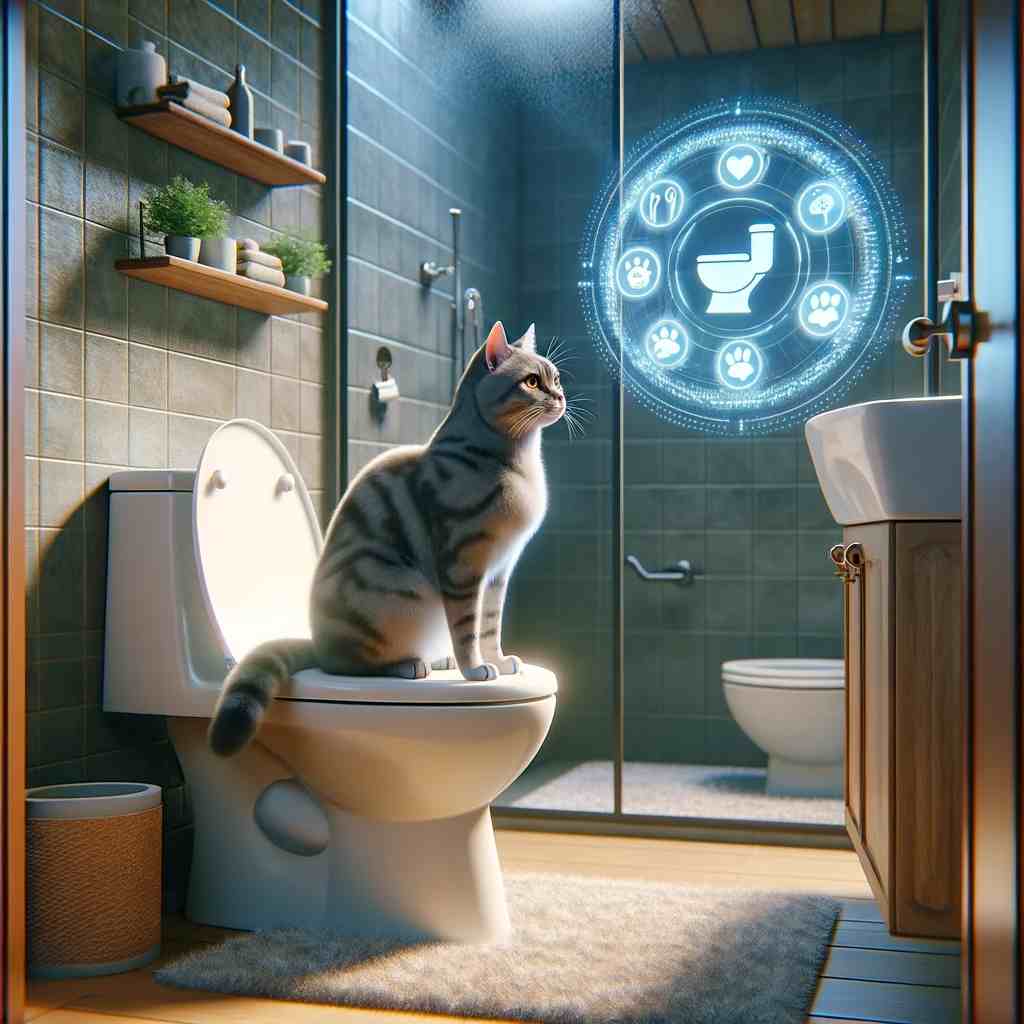
Each cat is unique, and toilet training is not a one-size-fits-all process. Before beginning, you’ll want to take into account your cat’s age, adaptability, and health.
Ensuring that your home setup supports this change is key.
This means that cats with health issues or who are set in their ways might find it more challenging, while kittens or cats with a flexible nature could adapt more readily.
It’s vital to consider whether this process is the best option for you and your fluffy pal, weighing the pros against any potential cons.
Key Takeaways
- Cat toilet training can reduce litter box chores and environmental waste.
- It’s important to account for a cat’s individual characteristics and health status.
- Success in cat toilet training requires time, patience, and a tailored approach.
How to Train Cat to Use Toilet: Preparing for Toilet Training
Essential Supplies for Toilet Training
First things first, gather your supplies:
- A toilet training kit (pick one that fits your toilet and has a sturdy base)
- Flushable cat litter (2)
- Gloves (for clean-up during the transition)
- Enzyme cleaner (accidents happen) (3)
- Your cat’s favorite treats (for positive reinforcement) (4)
Setting Up Your Home for Success
Now, let’s talk about your bathroom setup. Choose a bathroom that your cat can always access and follow these steps:
- Begin by placing your cat’s litter box near the bathroom. If it’s already there, bonus points for you!
- Gradually (we’re talking a tiny shift each day) move the litter box closer to the toilet.
- Once the box is next to the toilet, start elevating it. Use stable objects like phonebooks or a stack of newspapers to prevent any wobbly scares.
- Eventually, place the litter box on top of the toilet seat (lid closed, please). Make sure it’s secure to instill confidence in your cat.
Remember, patience is key! This isn’t a race; it’s about making your cat comfortable with each new change.
During this phase, ensure the toilet lid is always down (nobody wants an unintended swim), and the toilet training seat is ready to go when your cat is.
Happy training! With these steps, you’re well on your way to a litter-free life.
Step-by-Step Guide to Toilet Training Your Cat
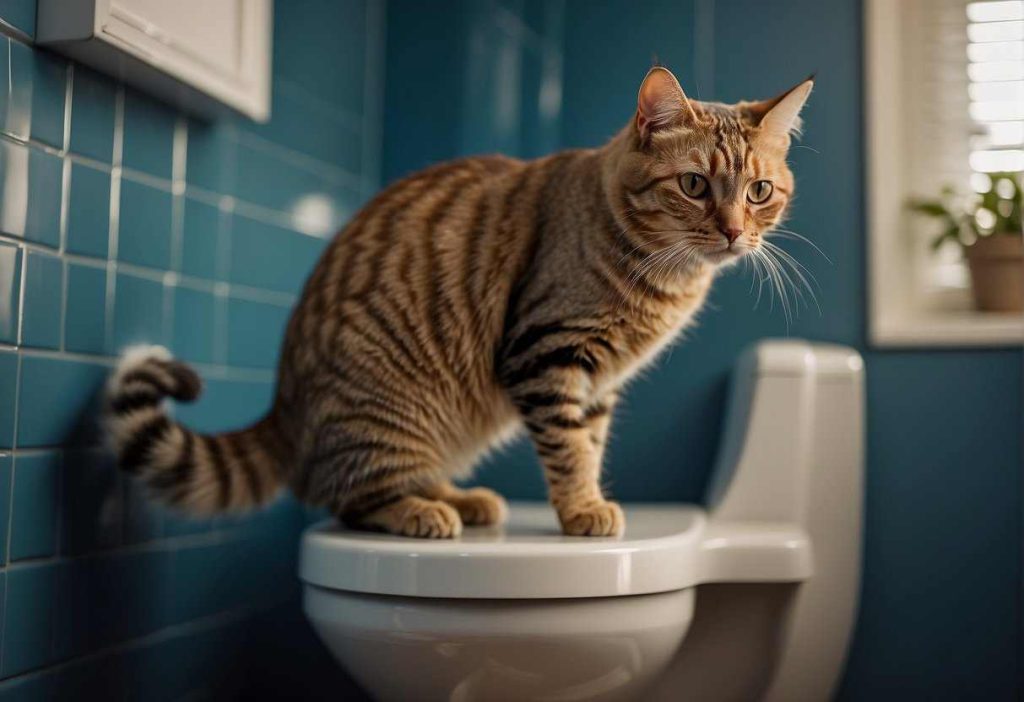
Introduction to the Training Process
Toilet training a cat involves patience and gradual steps. This approach ensures a smooth transition from litter box to toilet.
Step 1: Acclimatizing Your Cat to the Bathroom
- Move the litter box next to the toilet, allowing your cat to get used to the new hangout spot.
- Make sure to create a welcoming atmosphere by keeping the bathroom door open.
Step 2: Elevating the Litter Box
- Raise the litter box by placing stable objects underneath it.
- Keep an eye on your cat to ensure they’re comfy with the new height each day.
Step 3: Transitioning to the Toilet
- Substitute the litter box with a cat-specific training seat that fits on your toilet.
- Cheer on your kitty to jump on the toilet with treats and praise.
Step 4: Removing the Litter Box Completely
- Gradually fade out the litter, starting with just a thin layer.
- Monitor your cat’s behavior closely and only remove the training seat when they’re fully accustomed.
Remember, every cat’s pacing is unique, so let patience be your guide through this journey. Soon enough, you’ll wave goodbye to the litter box era!
Considering Your Cat’s Health and Behavior
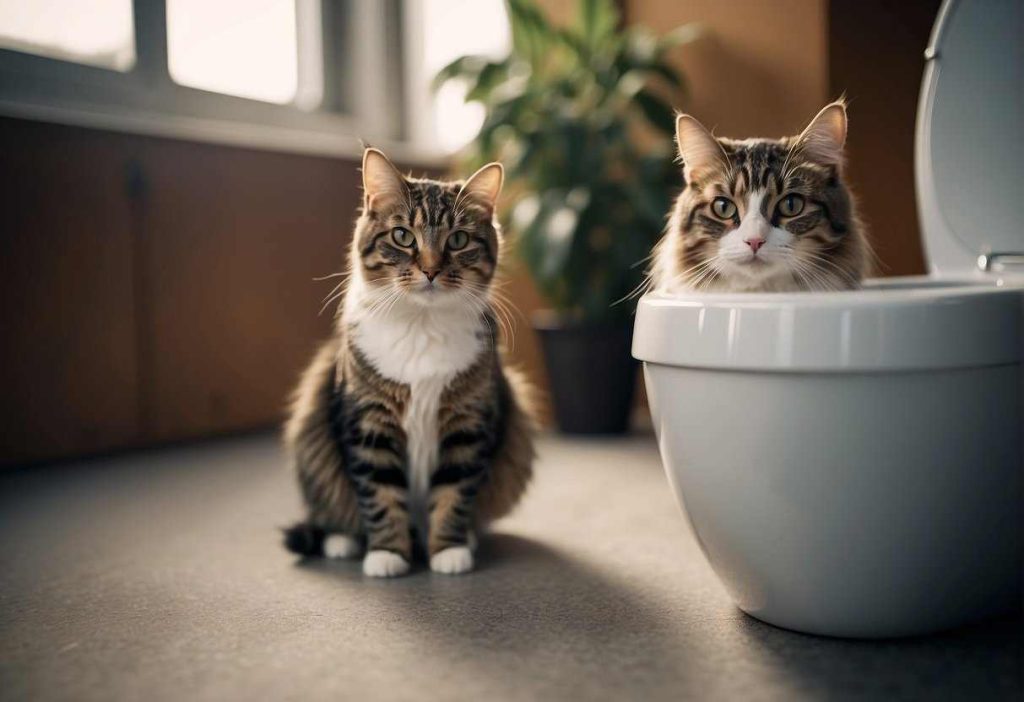
Health Impacts of Toilet Training:
What’s up with their health while making the switch? Well, toilet training might be a cool party trick, but it’s not all bells and whistles for your kitty’s well-being.
- Physical concerns: Perching on a toilet can be awkward for cats and may lead to muscle strain or imbalance. Always keep an eye on their posture!
- Psychological effects: Mastering something unnatural like toilet use might stress your cat. Look out for signs of anxiety or behavior changes. (5)
Behavioral Considerations:
Cats have instincts, and it’s super important to be a cool cat and respect them.
- Litter scratching: It’s like a cat’s signature move. It may seem like just a cute quirk, but this behavior is deeply ingrained and tied to their territory.
- Privacy preference: Ever noticed your cat values their alone time? The bathroom hustle and bustle may not be their jam.
Remember, no cat’s the same, and if yours doesn’t take to the throne like royalty, that’s okay. Watch for clues in their behavior and be the understanding human they need.
After all, it’s about their comfort, not just showing off their posh potty habits!
Keep it chill, observe, and let your kitty guide the process. Here’s to happy and healthy toilet times!
Balancing the Pros and Cons
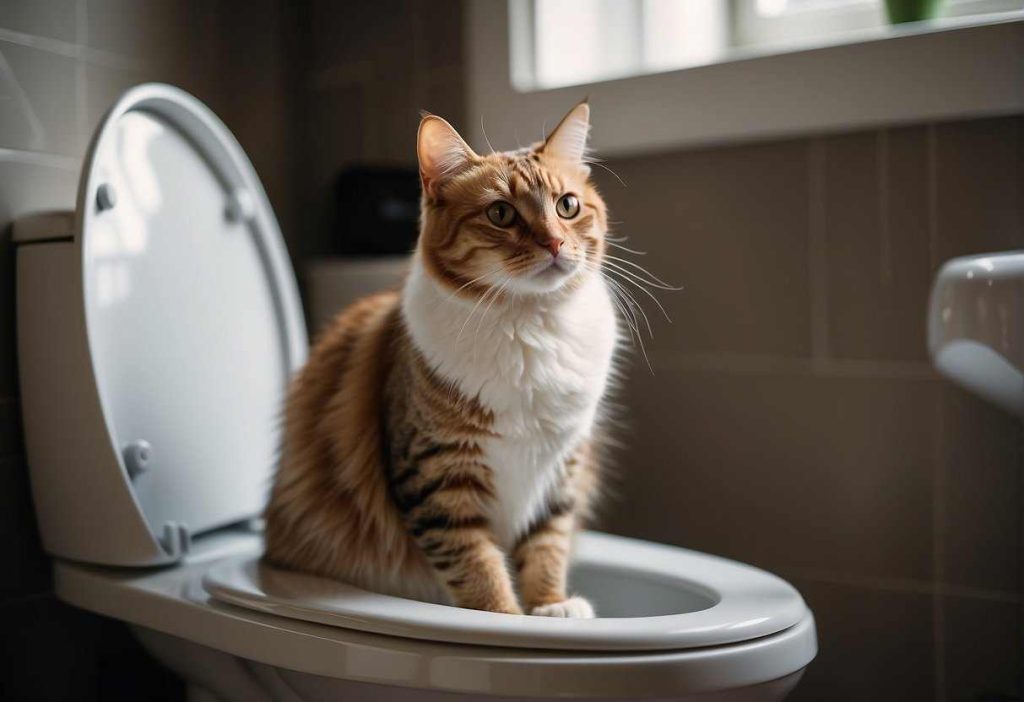
Benefits of Toilet Training Your Cat
Have you ever wanted to ditch the litter box for good? Training your kitty to use the actual toilet could be the golden ticket!
Not only does it ramp up the hygiene factor by leaps and bounds, but it’s also kinder to Mother Earth.
Just think, no more amassing plastic bags of used litter! Plus, your wallet might give you a high-five with the cost savings. Who wouldn’t want a few extra bucks?
- Hygiene: Say goodbye to litter scattered across the floor.
- Environmental Impact: Less litter means less waste. (6)
- Cost Savings: Avg. annual litter cost = $165. That’s a saving!
Potential Downsides and How to Mitigate Them
Now, let’s not put on rose-colored glasses here. There could be a hiccup or two along the way. For instance, a cat might find the toilet perch a bit precarious.
- Some cats might resist the change or find it stressful.
- Accessibility concerns for kittens or senior cats. (7)
- Possibility of accidents.
| Concerns | Mitigation Strategy |
|---|---|
| Resistance to Change | Gradual introduction and positive reinforcement |
| Accessibility | Consider a step or ramp |
| Accidents | Keep an extra litter box during transition |
But fear not! With a sprinkle of patience and a dash of expert advice, many of these cons can be managed.
- Expert Tip: Start young, but not too young.
- Practical Advice: Keep the process stress-free, and always have a plan B.
Remember, all fur families are different, so what’s the cat’s meow for some, might have others hissing.
Snag some advice from your vet or a feline behaviorist if the water gets choppy. Your furry friend will thank you for it!
Troubleshooting Common Issues and Setbacks
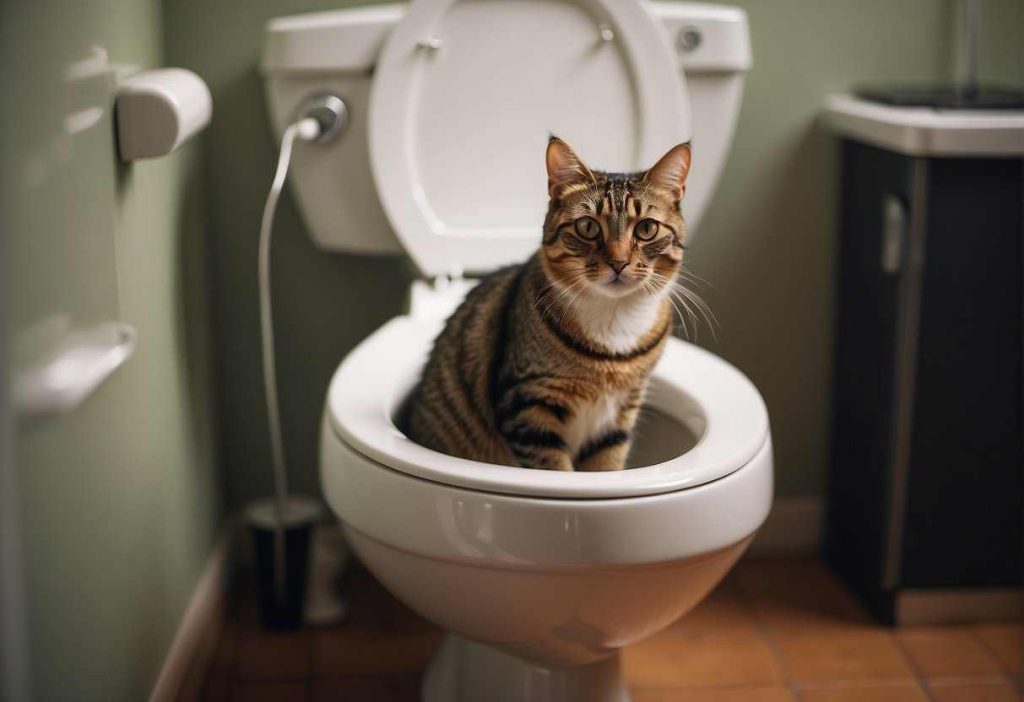
Addressing Accidents and Behavioral Changes
- If your cat misses the toilet:
- Confirm the toilet seat is stable; a wobbly seat may discourage your cat.
- Place their litter box closer to the toilet.
- Gradually raise the box’s height until it’s level with the toilet.
Practical tip: Cats love consistency, so keep the training steps small and steady.
Encountering resistance or behavioral changes? Consider these points:
- Ensure the litter in the training kit is similar to their usual litter.
- Maintain a clean toilet and training kit to entice usage.
- Praise and reward your cat for progress, big or small.
Knowing When to Pause or Stop
Sometimes, despite our best efforts, our cat’s comfort and happiness come first. Here’s how you can spot if it might be time to reconsider:
- Overwhelming stress signs like excessive meowing or avoidance of the toilet area.
- Physical difficulty or inability to balance on the rim of the toilet, especially in older or less agile cats.
If these issues persist, it’s okay to press the pause button on training or to consider whether this is the right approach for your particular pal.
Always prioritize the well-being of your cat, after all, a happy cat makes for a happy home!
Alternatives to Toilet Training

Innovative Litter Box Solutions
Who said litter boxes can’t be cool? Check out these options:
- Automatic Litter Boxes: Tired of scooping? Automatic litter boxes are here to save your day. They scoop the waste for you and keep the box pristine.
- Hidden Litter Boxes: Not a fan of having your litter box on display? Hidden boxes can be disguised as furniture, blending seamlessly with your decor.
Table 1: Innovative Litter Solutions Compared
| Feature | Automatic Litter Boxes | Hidden Litter Boxes |
|---|---|---|
| Maintenance | Low | Medium |
| Aesthetic | Functional | Stylish |
| Space Requirement | Moderate | Variable |
Environmental and Health Considerations
Looking out for the planet and your kitty’s health? Here’s how:
- Sustainable Litter: Choose biodegradable options like recycled paper or wood pellets. These are not only better for the Earth but often healthier for your cat, reducing the risk of allergies and respiratory issues.
- Health Benefits: Sustainable litter can be less dusty and, thus, gentler on your pet’s lungs. Plus, those paw-friendly options mean a cleaner home with less tracking.
Bullet Points on Benefits of Sustainable Litter:
- Good for the planet
- Reduces respiratory risks
- Less dust and tracking
Remember, choosing the right litter solution enhances your cat’s comfort and your convenience. A happy cat means a happy home!
Success Stories and Personal Experiences

Jasper’s Journey:
- Age: 2 years
- Training duration: 4 weeks
- Trick: Loves to flush!
Jasper, a lively tabby, was skeptical at the start. But with patience and treats, he now not only uses the toilet but also enjoys the flush sound. His owner, Rachel, shares that consistency was key.
Fluffy’s Feat:
- Age: 1 year
- Training duration: 6 weeks
- Note: Has her special signal!
Fluffy, an adorable Persian, took a bit longer. Her human companion, Tom, used a special jingling bell to signal toilet time. Now, Fluffy rings the bell herself when it’s time to go!
Training Tips to Tick:
- Patience: It’s a virtue!
- Routine: Stick to it.
- Reward: Praise and treats do wonders.
These little furballs have made their humans proud by mastering an unusual skill. Your cat could be next—imagine the bragging rights! And think of the litter you’ll save.
Are you ready to embark on this toilet-training adventure with your feline friend? Let’s get to it and make your cat a part of these success stories!
Quick Recap
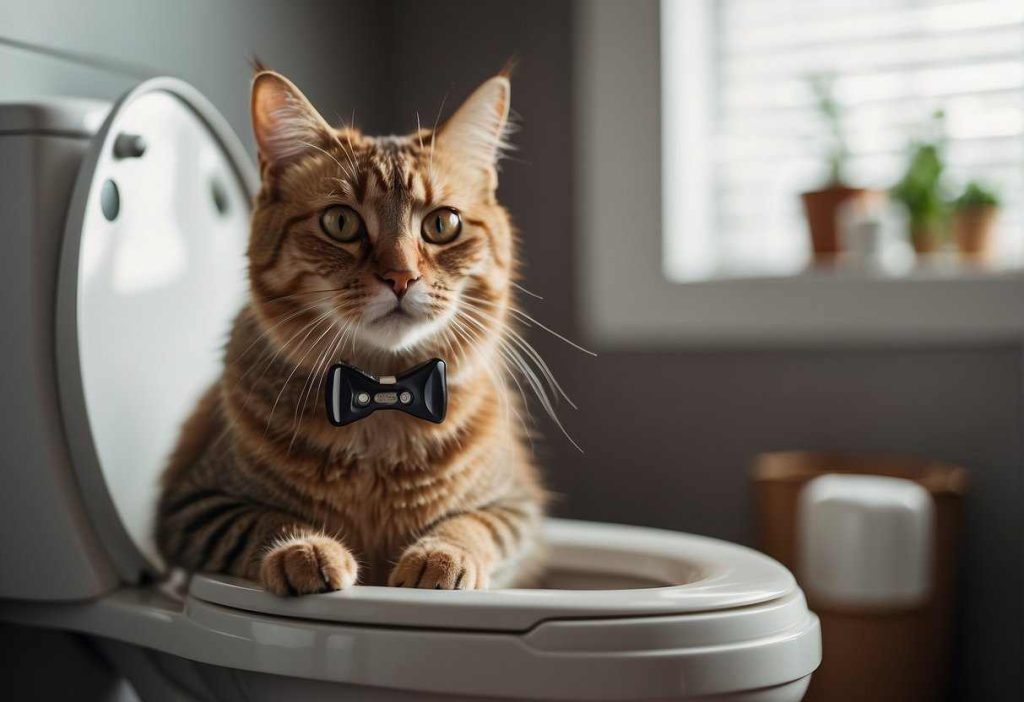
Before jumping in, let’s make sure we’re on the same page. Are you sure your furry friend is ready to trade the litter box for the loo? Here’s what you need to chew over first:
- Age and Health: Kittens and senior cats might find it tough. It’s best for the in-betweeners with no health issues.
- Temperament: If your kitty could win a gold medal in stubbornness, this might not be their cup of tea.
- Consistency: Got a steady routine? You’ll need it. Training takes patience and persistence.
Remember, this isn’t a sprint; it’s more like a marathon with a view.
If you decide to go for it:
- Prepare the bathroom – safety first!
- Get the right training kit – no cutting corners!
- Take it slow – small steps lead to big leaps.
- Positive reinforcement – treats and praise work wonders.
| Consideration | Importance |
|---|---|
| Cat’s Age and Health | High |
| Cat’s Personality | High |
| Your Schedule and Patience | High |
| Safety Precautions | High |
| Training Kit Quality | High |
| Pace of Training | Moderate |
| Use of Rewards and Encouragement | High |
Frequently Asked Questions
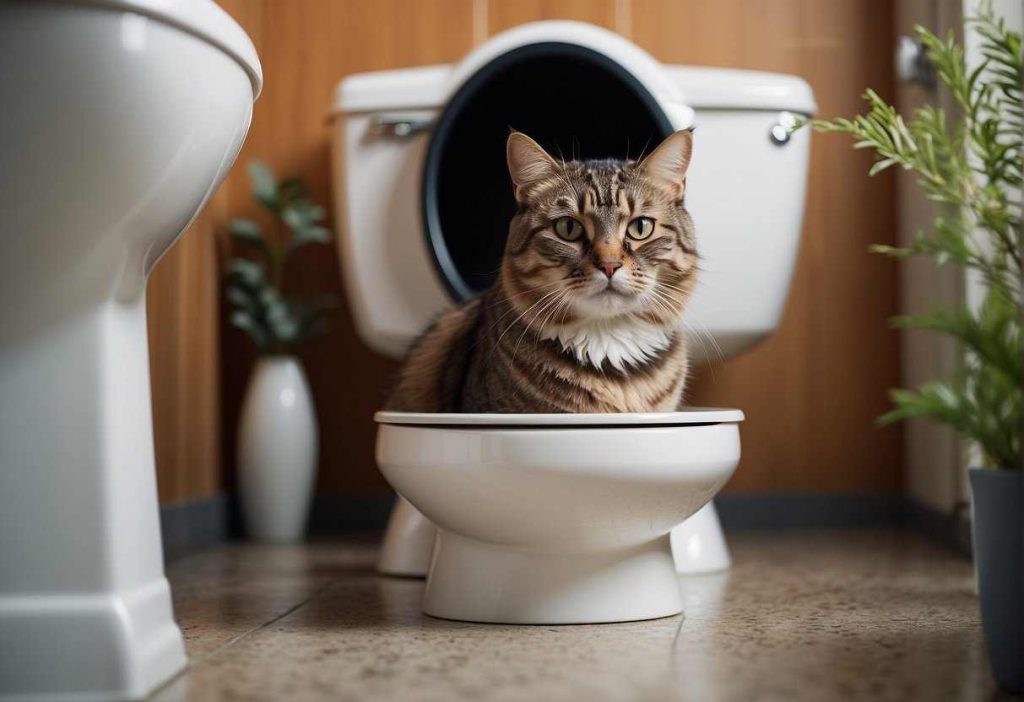
Toilet training a cat can be a rewarding experience that not only helps maintain a cleaner home but also harnesses the natural instincts of your feline friend.
In this section, we’ll cover some common questions about the process, ensuring you have all the knowledge at your fingertips.
How long does it typically take to toilet train a cat?
Expect toilet training to take about three to eight weeks. Much like humans, each cat has a unique learning curve, so patience is key.
Stick with it, and you and your kitty will get there.
Can older cats be toilet trained successfully?
Yes, senior cats can learn new tricks! The key is to transition them gradually and be sensitive to their comfort levels and physical abilities.
What are the signs my cat is not adapting well to toilet training?
If your cat is avoiding the toilet, showing distress, or has changes in eating habits, they might not be adapting well.
It’s important to spot these signs early and adjust your technique or seek guidance.
Is toilet training safe for my cat’s health?
When done correctly, it’s safe. Ensure the toilet seat is stable and the training process is gradual to avoid stress or accidents.
How can I monitor my cat’s health without a litter box?
Keep an eye on your cat’s stool and urine in the toilet for any changes. Consider a regular veterinary check-up to stay on top of their health.
What should I do if my cat refuses to use the toilet?
If your cat resists, take a break and evaluate your approach. Some cats may prefer a litter box, and that’s okay. Their comfort is paramount.
Are there environmental benefits to toilet training my cat?
Absolutely! Toilet training reduces the need for litter, which can be environmentally taxing due to its production and disposal processes.
Plus, you’re sparing yourself from the daily litter box scooping ordeal.


